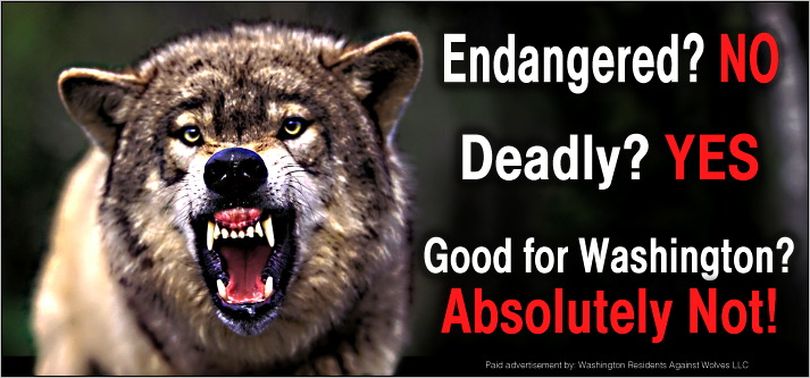Anti-wolf group initiates Spokane billboard campaign

PREDATORS -- A newly organized anti-wolf group says it's targeting Spokane with a billboard campaign "to inform residents about the reality of an increasing number of wolves in Washington State," according to a media release posted today.
Four billboards featuring a snarling wolf are being put up, according to Washington Residents Against Wolves, an activist group that says it's promoting "sound management of the predator."
Billboards are up at Lincoln Road and Division Street and Lincoln Road and Market Street.
“The aim of the billboard campaign is to encourage people to ask more questions about what having wolves in Washington really means,” said Luke Hedquist, WARAW member.
“People need to consider the challenges associated with wolves. Wolves can and will attack people, livestock will be killed and maimed, private property will be compromised and local economies will be impacted. We want to make sure people thoroughly understand the issue, so we started by trying to get people’s attention with the billboards.”
The initial billboard message features a photo of a wolf, teeth bared, and the text: “Endangered? No. Deadly? Yes. Good for Washington? Absolutely not.“ A total of eight billboard posters are planned to be up by the end of the month, Hedquist said.
"One of the key items not being discussed is how quickly wolves will deplete wildlife herds in the state," Hedquist says in the media release.
Washington has about 14 identified wolf packs and had a minimum of 52 wolves before this year's breeding season.
“We know by watching wolves in other states that it is common for the population to increase by 38 percent on average each year,” said Hedquist.
This is bad news not only for predators who must compete for available prey in the affected ecosystems, but also for the communities that depending on seasonal hunting revenue, he said.
“As the elk and other ungulates are impacted by wolves, we will see fewer animals for other predators like cougar and bear; a decline in the number of animals available to hunt and significant impacts to local economies as hunters go elsewhere,” Hedquist said.
“It’s also important to remember that at this point, wolves are not moving across Washington and WDFW is making no moves to either reduce the number of wolves or translocate the Eastern Washington excess to other parts of the state. So we should be prepared for Eastern Washington to bear the full brunt of the cost. Frankly, that cost is unacceptable.”
